April 29 - May 5, 2012: Issue 56
If you lived anywhere on the east coast of NSW in 1974, you might remember the famous storms of that year. They were memorable for the damage they caused – such as the loss of the beach sand; the damage to the apartment blocks at Collaroy Beach, and destruction of the Manly fun wharf and Harbour pool enclosure. In the storm I am writing about in this story, the storm-surge was sufficient to stop the tide running out of Pittwater and the Hawkesbury River, while the planks of the Palm Beach Wharf were under water!
It was a Sunday afternoon in June and the three-man crew of police launch “Falcon” had just returned to its home base Church Point. The boat had been refuelled the radio operator received a call to attend a boat in distress off Tuggerah; it had been seen roll over in the bombora by the local lifesavers, who were unable to reach it in their power boat. ‘Falcon’ was turned around and set off for Broken Bay, where the crew were astounded by the size of the swell running from SSE. A decision had to be made and all agreed they would never forgive themselves if they didn’t try and someone drowned. So they went. It was many hours later that the exhausted crew with their rescued survivors of the ketch ’Votan’ finally returned to Pittwater around one o’clock in the morning. They had all endured many harrowing hours battling huge seas and gale-force winds - the flashes of the ‘Joey’ lighthouse never looked so good as they did that night.
The Sketches
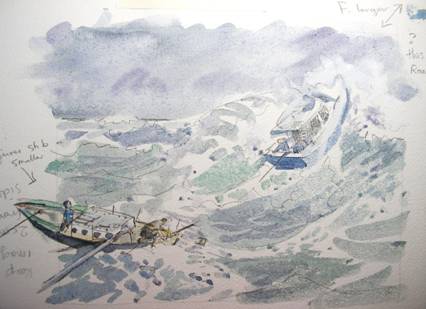
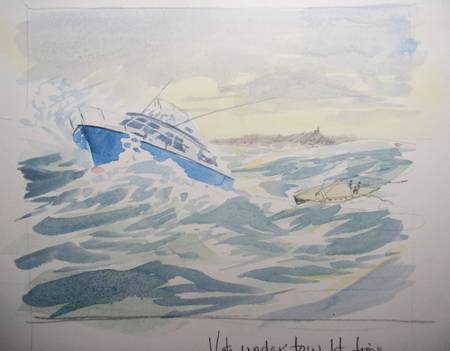
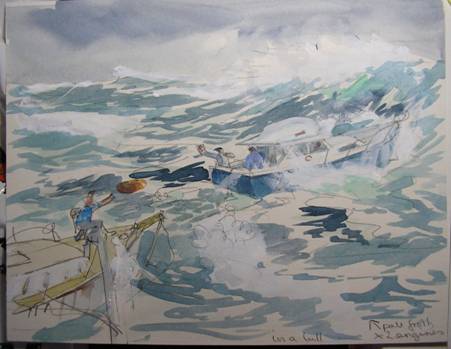
The Paintings
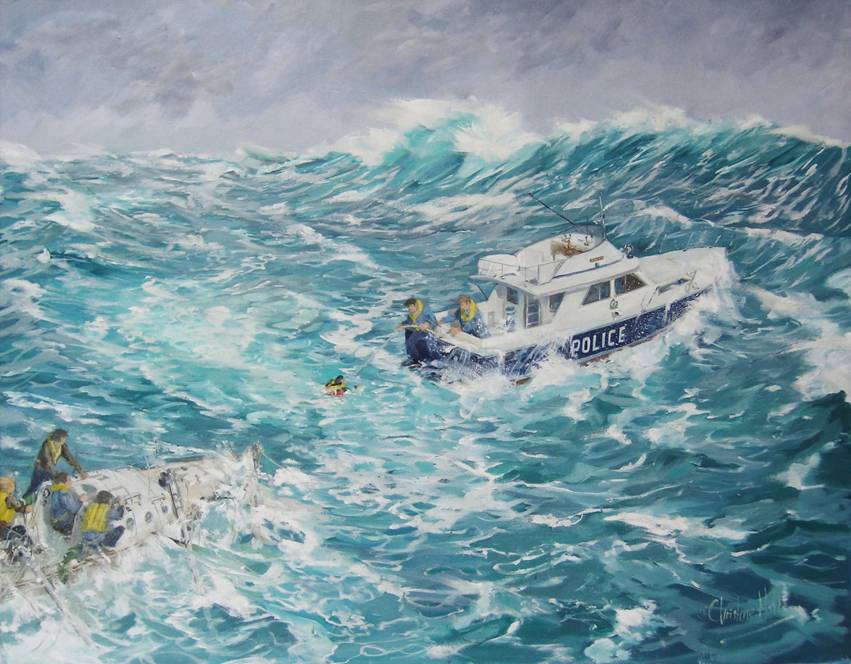
In the Tuggerrah Bombora
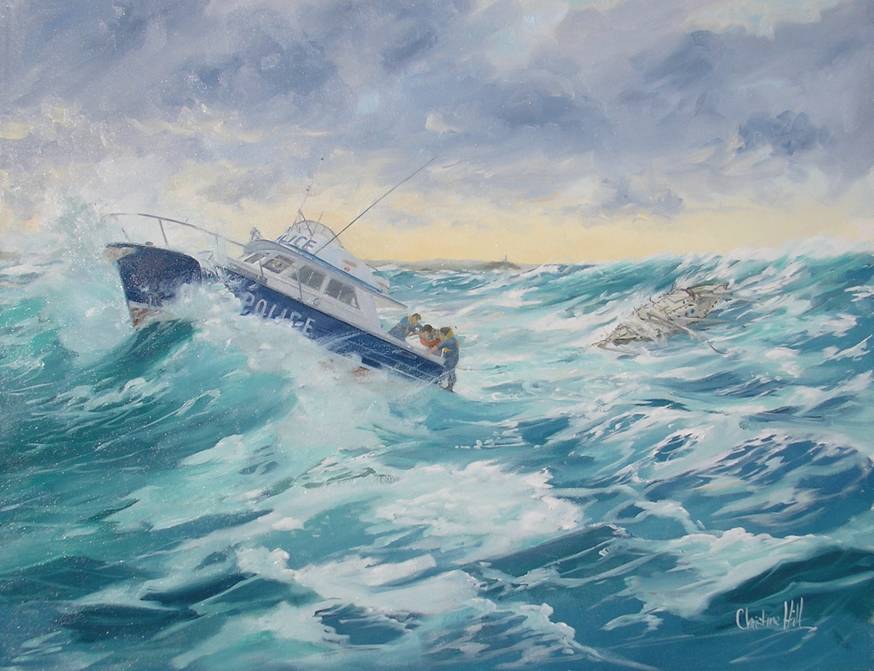
Last Man Aboard
The Story of the making of the paintings illustrating the “Falcon” rescue of “Votan” and her crew – Sunday 9th June 1974
by Christine Hill FASMA, written October 2011
I am an artist. I draw, and I paint pictures – telling a story with imagery rather than words. It’s something I’ve been doing since I could first pick up a pencil, and I often wonder whether the hours
I spent poring over the illustrations in children’s adventure books influence my interest in illustrating events of the past for which there are no photographs. Stories are told or recorded, but it is left to the imagination of the listener or reader to paint a picture in their “mind’s eye”.
There are many members of the Australian Society of Marine Artists who do just this – we hear a tale which interests us and we research and study, interview, visit locations, sketch and generally piece together as much information about a topic as we can to enable us to compose a painting depicting the crucial elements of the story. Stories from history books feature largely in marine paintings, but we are also able to record events which although ‘historic’ have actually happened in our own lifetime!
And so it was with the story of the ‘Falcon’ and the ‘Votan’ which came to me through family connections. There were three crewmen on the Police launch ‘Falcon’ – Roper (Buster) Brown, Brian (Friendly) Friend and Gordon (Boot) Wellings – and it was at the sad occasion of Gordon’s funeral in 2010, when the story was told by his mates, that the inspiration came to me to paint this event.
I was very fortunate that Jean Wellings and Friendly were able to give me lots of help with the details of the story and some photographs of the ‘Falcon’ taken in the 1970s and I spoke at length with both of them.
Gradually details were amassed: the danger and drama was largely about the huge seas and high winds – there was no rain falling, although everyone was drenched! The sun was low over the western horizon and the sky to the south and east was “black”. The spray was horizontal and the waves were “three times boat length” and capping. The policemen wore faded blue overalls, the survivors from Votan put on lifejackets after the roll-over (I have one in my shed of that vintage!) and everyone was soaked. There were no life-lines, so Boot held Friendly by his belt when he stood on the stern board to pull the survivors aboard. There was no door in the back of the boat and they all had to be hauled up and over. Buster Brown was at the controls the whole time and could only be depicted as a shadow at the window.
As for ‘Votan’, she was half-full of water and wallowing; her colour was indeterminate and I had only one faded photo taken some time before the event, to give any idea of her looks. She appeared to have a canoe stern, and the record states that after she rolled, her masts were broken, with stays and gear trailing.
I though hard about the scene and sketched up several watercolour pictures. These little sketches show the erasures and re-working of ideas but it’s important to set things out before starting - putting the right mark in the right place first time helps tremendously to get a painting going – detail comes later. With a detailed cut-out drawing of ‘Falcon’ I thought about where to position the boats, the waves, the direction of light – even whether Norah Head Lighthouse could be included, to ‘set the scene’.
Should I paint the dramatic moment when the tow-line was cut by the giant wave or when the survivors were being pulled across? Look into the sunset, or out at the storm? The difficulty of making an interesting painting of the trip back to Pittwater, after ‘Votan’ had to be cast adrift in howling darkness with no moon to illuminate the scene caused that idea to be abandoned. What about the scene inside ‘Falcon’- Buster at the helm, fighting to keep the heading and easing the malfunctioning starboard engine over every wave? Boot at the radio/navigation table? Friendly attending to the rescued and injured lying in blankets on the floor? Lots of decisions had to be made.
I stretched up two canvases as by then I had determined that two paintings were needed. Work stopped several times while I contacted Friendly to check details – “Are you right-handed?” “You stood on the stern-board - when?” “Oh, you mean there was no tow attached at that point?” “How close?” “How big?” “Two engines?” Imagine Falcon coming across and turning to go just close enough alongside Votan, churning aqua water and foam. Imagine the last man being brought aboard, just as the sun set, leaving 'Votan’ attached to the tow again.
It took about a week of thinking and painting to finish each picture. Then a few more weeks of looking at it – fetching the palette out of the freezer, thawing the paint and making a little alteration here and there – borrowing a good camera and setting up the tripod and easel in the correct outdoors light to make a photograph of each one. That’s the finish! The really hard part now is deciding on how to frame them.
(A famous artist once told me you have to know when a painting’s finished before it’s finished. Great advice, but so hard to follow......!)
Footnote:
The whole rescue journey demanded exemplary courage of Falcon’s crew, with a high degree of skill and seamanship, and they were all recommended for bravery awards. Buster, Boot and Friendly all received the Thiess Toyota Bravery Award, and the Commissioner’s Commendation at a passing-out parade later that year. Mrs Wedgewood (of English fine china) whose son had been lost from the yacht, flew out from England and presented each of the crew with a piece of unique china that is still a reminder of that fateful day. Then, in September the following year, in a ceremony at Government House, the Governor General Sir Roden Cutler presented each with a medal – the Queen’s Commendation for Brave Conduct.
Copyright Christine Hill 2012. All Rights Reserved.
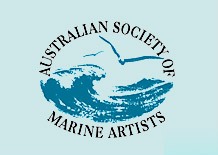 Supporting Marine and Maritime Art in Australia
Supporting Marine and Maritime Art in Australia
The Australian Society of Marine Artists is a body of diverse artists and others interested in marine and maritime art . . . painters, lithographers and printmakers, sculptors, model-makers, historians and students. Among our members we have every painting style represented - from traditional to contemporary, realist to abstract.
'Celebrating a Maritime Year'
ASMA Exhibition
Lady Denman Heritage Complex
Huskisson, NSW South Coast
Sat 17 March – Sun 27 May 2012
10am – 4pm, daily